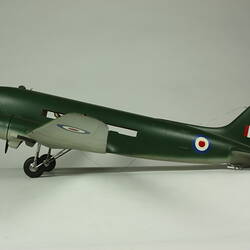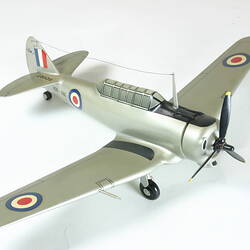Summary
Dropping supplies by air to Australian troops in the jungle during World War II was a difficult problem. Ordinary silk parachute canopies were expensive and used valuable material. Dropping supplies from aircraft without a parachute frequently led to destruction or loss of the stores. In 1943, an experimental wire mesh suspended net was erected at Langwarrin, Victoria into which supplies including cordial bottles were dropped from a 67 Squadron Avro Anson aircraft. This method was not adopted.
The wartime Inventions Directorate in Australia led by L.J. Hartnett (later Sir Laurence Hartnett) asked the Ordnance Production Directorate to find a solution and G.W Griffiths was seconded to examine the problem. He devised a container made of heavy-gauge wire netting to absorb the shock of impact with the ground which he called the 'Aeropak'. A parachute could be attached to slow the rate of descent.
The Melbourne printing firm of Morris & Walker Pty Ltd improved the design by using a three foot long heavy cardboard cylinder which could hold 250 lbs of supplies and used a hessian parachute packed in the rear. The pointed nose is hollow to absorb some of the impact. The new design was called the 'Storpedo'. Test drops from a C-47 aircraft were conducted at Nadzab in New Guinea in 1944 which proved the effectiveness of the unit. Several thousand were made and used by Australian and US forces in the South-West Pacific. They could be fitted under the wing of smaller aircraft such as the CAC Wirraway which enabled a more accurate drop to occur. At the end of the war, the Storpedo was used to drop supplies to prisoners of war in Timor. The design was patented under the names of E.R. Campbell, K.M. Frewin, F.W. Lennox and R.P. Morris. In the post-war years the Storpedo was used to drop supplies to flood victims in NSW.
Model History
This 1:4 scale model of the Storpedo was donated to the Museum by one of its designers Mr K.M. Frewin.
More Information
-
Collecting Areas
-
Acquisition Information
Donation from K. M. Frewin
-
Designer
K. M. Frewin, Melbourne, Greater Melbourne, Victoria, Australia, circa 1944
-
Brand Names
-
Classification
-
Category
-
Discipline
-
Type of item
-
Model Scale
1:4
-
Keywords
Air Transport, Military Aviation, Scale Models, Wars & Conflicts, Innovation & Design




